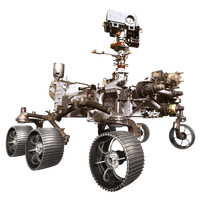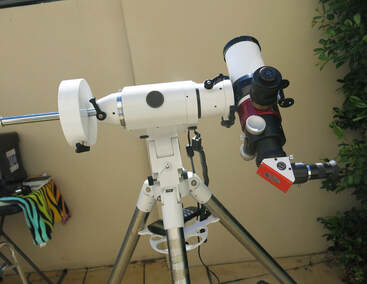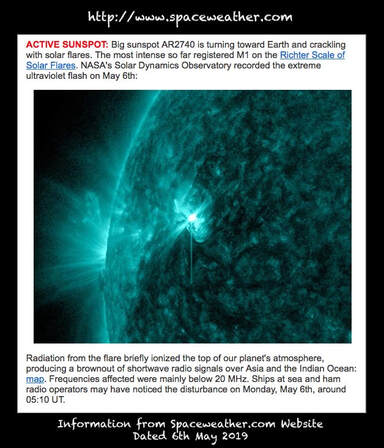|
Jupiter is now looking stunning in our evening sky with its multi coloured bands of swirling clouds that surround the planet. The patterns change every year with each opposition, but this year something more unusual is happening.
Jupiter’s Great Red Spot appears to be unravelling and dark coloured gases are jet streaming away from this massive cyclonic storm. I think it’s just so awesome that we can see this happening right now! I’ve also captured a long dark blue filament or festoon breaking away from the dark North Equatorial Belt and there are lots of smaller ones running along the edge of the belt which is quite remarkable…Jupiter is just so exciting to observe at the moment :-) My image was taken on the 30th May 2019 with a Meade LX200 10inch telescope at prime focus using a ZWO ASI120MC-S camera with a 3x Barlow lens attached. AVI movie files of 2000 frames were captured which were stacked in RegiStax6 and processed in PS CS4. Saturn is now back in our evening sky but opposition is not until the 9th July so its still looking a little small in the eyepiece of my Meade 10inch Schmidt-cassegrain telescope.
This is my first image of Saturn for this year while I was out taking images of Jupiter on the 30th May 2019, the sky condition were not too good but I did mange to get some detail :-) My image was taken with a Meade LX200 10inch telescope at prime focus using a ZWO ASI120MC-S camera with a 3x Barlow lens attached. AVI movie files of 2000 frames were captured which were stacked in RegiStax6 and processed in PS CS4. Jupiter is now in the sky for prime viewing and for us to enjoy…that is, if you can get a clear and steady night of seeing…good luck everyone! On the evening of the 29th May three of the Galilean moons of Jupiter made a perfect isosceles triangle with the body of Jupiter, which looked lovely in the night sky :-)
To capture the wide field view of Jupiter with the moons Io, Europa & Ganymede, I attached a focal reducer to the little ZWO planetary camera, which was inserted into a large telescope. There was a fast flowing jet stream in the sky so the seeing was not the best, but I did managed to capture a few AVI movies for these images. For the full image of Jupiter you can just see the Great Red Spot coming into view on the limb but the seeing went right off and I was unable to get any more images until later. Images taken with a Meade LX200 10inch telescope at prime focus with a ZWO ASI120MC-S camera with a focus reducer attached for the wide field and a 2x Barlow lens for the full image of Jupiter. AVI movie files captured and stacked in RegiStax6 and processed in PS CS4.  Mission Facts Launch Window July 17 - Aug. 5, 2020 Launch Location Cape Canaveral Air Force Station, Florida Landing Feb. 18, 2021 Landing Site Jezero Crater, Mars Mission Duration At least one Mars year (about 687 Earth days) NASA's Mars 2020 Rover is heading to the Red Planet. Submit your name by Sept. 30, 2019, 11:59 p.m. ET, and fly along! https://mars.nasa.gov/participate/send-your-name/mars2020/ https://mars.nasa.gov/participate/send-your-name/learn https://mars.nasa.gov/mars2020/  NASA News: May 21, 2019 NASA Invites Public to Submit Names to Fly Aboard Next Mars Rover All Aboard for Mars 2020: Members of the public who want to send their name to Mars on NASA's next rover mission to the Red Planet (Mars 2020) can get a souvenir boarding pass and their names stenciled on chips to be affixed to the rover. Sign up at go.nasa.gov/Mars2020Pass. Image Credit: NASA/JPL-Caltech. Full image and caption › Although it will be years before the first humans set foot on Mars, NASA is giving the public an opportunity to send their names — stenciled on chips — to the Red Planet with NASA's Mars 2020 rover, which represents the initial leg of humanity’s first round trip to another planet. The rover is scheduled to launch as early as July 2020, with the spacecraft expected to touch down on Mars in February 2021. To read more about this exciting new mission Mars please go to: https://mars.nasa.gov/news/8440/nasa-invites-public-to-submit-names-to-fly-aboard-next-mars-rover/  We had such a beautiful clear day here today, so I raced home and spent most of the day imaging our Sun with my different cameras and telescopes to capture these two big sunspots. Active region AR2740 has now split up which can be seen quite clearly and the new sunspot AR2741 has a very dark umbra and a large penumbra area surrounding it. It looks like this one is going to be quite an active sunspot too! These images were taken with my 127mm refractor telescope with a glass solar filter attached using a Canon 700D camera. The first image was taken with a ZWO ASI 120MC-S camera with a 2x Barlow lens.  Information from Spaceweather.com Website Information from Spaceweather.com Website Late yesterday afternoon at 4pm (AEST) I got the biggest thrill when I put my little 60mm Lunt solar telescope onto my mount and pointed it at the Sun and saw AR2740 going off like a rocket!!! These four images were taken over just 10 minutes in duration and it was very exciting to watch and capture. If you look closely at the active region (middle of image) you’ll see the solar material being blasted away and travelling across the surface of the Sun as a dark mass of plasma…a small CME in motion! I was very lucky to capture this event as the Sun was getting very low and I’d just packed away my refractor telescope, I just thought I would take a peek at the Sun in H-alpha to see if it was doing anything exciting…and Wow, it was! Images taken with a Lunt 60mm solar scope and a ZWO ASI 120MC-S camera at prime focus, I captured AVI movie files and stacked them in RegiStax6 and processed in PS CS4…there was also a small prominence on the eastern limb so maybe there is another sunspot coming…. Note from Noeleen: If you watch the slideshow you will see the path of the solar material being blasted away from the Sun over just a few minutes...Wow! The next day an image of this solar flare from the Solar Dynamics Observatory was posted on Spaceweather.com http://www.spaceweather.com https://sdo.gsfc.nasa.gov After so long with no activity on the surface of the Sun we now have a huge active sunspot designated AR2740 which is the twice the size of Earth. I set up both my telescopes this afternoon and finally the clouds cleared long enough to take some images. I had to be quick because clouds were rolling across the sky! For the full disc of the Sun I used a Meade 80mm refractor telescope with a solar filter attached and a Canon 700D camera with a 2x Barlow lens, the exposure time was 1/320th second and ISO 200. For the high magnification image I used a ZWO ASI 120MC-S camera with a 2x Barlow lens, 2000 frame AVI file stacked in RegiStax6. Information from Spaceweather.com on the 6th May 2019
ACTIVE SUNSPOT: Big sunspot AR2740 is turning toward Earth and crackling with solar flares. The most intense so far registered M1 on the Richter Scale of Solar Flares. NASA's Solar Dynamics Observatory recorded the extreme ultraviolet flash on May 6th. http://www.spaceweather.com https://sdo.gsfc.nasa.gov https://sohowww.nascom.nasa.gov |
AuthorI just love being under the heavens, come on a journey with me and I’ll share some of the amazing wonders of the Universe with you. Noeleen :-) Archives
June 2024
Categories
All
|

For all current observations of the night sky please go to my Astro Blog:
http://www.mystardustobservatory.com/astro-blog
Copyright information:
You are welcome to use my images for educational and private use, please credit me.
If you need higher resolution images then please contact me on my contact page, thank you.
http://www.mystardustobservatory.com/astro-blog
Copyright information:
You are welcome to use my images for educational and private use, please credit me.
If you need higher resolution images then please contact me on my contact page, thank you.













 RSS Feed
RSS Feed